Africa is home to some of the world’s most famous birds, including those that are known for their sizes.
From the iconic African ostrich and enormous wandering albatross to the majestic African martial eagle, these avian giants have captivated the attention of both scientists and nature enthusiasts for centuries.
In this article, we will take a closer look at some of the most notable large African birds and explore their unique characteristics, behaviors, and habitats.
Table of Contents
Big African Birds
1. Shoebill
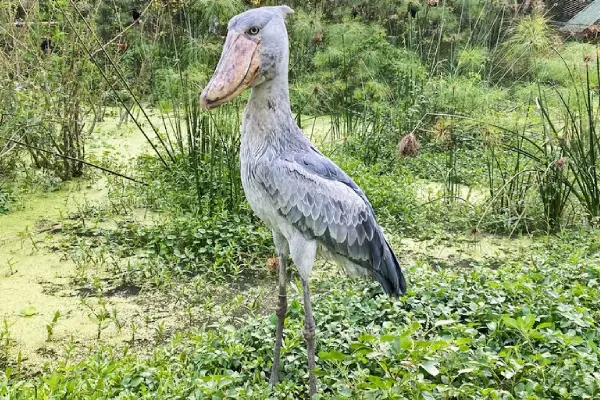
- Scientific Name: Balaeniceps rex
- Length: 39-55 in
- Wingspan: 90.5-102.3 in
- Weight: 8.8-15.4 lb
Shoebills are the largest blue birds in the world. They can grow to a height of 5 feet, a length of almost 4.6 feet, have a wingspan of 8.5 feet, and weigh as much as 15.4 pounds.
Shoebills’ most prominent feature, besides their enormous size, is the huge beak that ranges from 7.4 to 9.4 in, making it the third-longest, after pelicans’ and large storks’. People often call them “whaleheads” due to their oversized shoe-shaped beaks.
Shoebills are blue-gray and have darker slaty-gray flight feathers. Some might even have exotic pale blue eyes that are quite mesmerizing to stare into.
They are common around freshwater swamps and marshes of East Africa, in Uganda, Sudan, the eastern DR Congo, Zambia, Kenya, Ethiopia, Botswana, and Tanzania.
People in the 1840s described a shoebill as “…an extraordinary bird, as big as a big camel, with a bill like a pelican’s, though wanting a pouch.“ They might also emit clattering sounds that people describe as a machine gun being fired.
Illegal trading, high demand, and extremely rare breeding in captivity have placed these fascinating birds on a list of endangered species. Some estimates claim a population ranging from 5,000 to 8,000 individuals.
2. Verreaux’s Eagle-owl
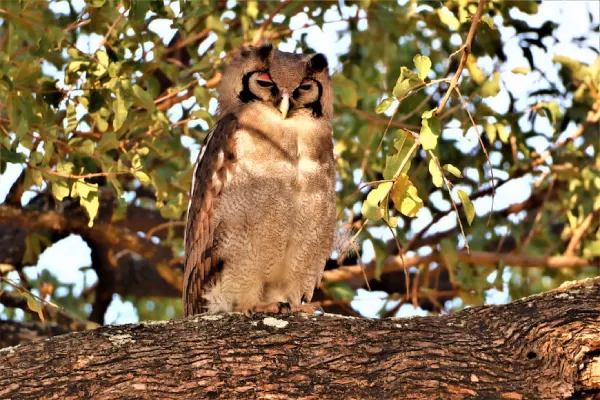
- Scientific Name: Ketupa lactea
- Length: 23-26 in
- Wingspan: 55-64.5 in
- Weight: 3.6-6.9 lb
Verreaux’s eagle-owls, also known as giant eagle owls, are the largest owl species in Africa and the world’s largest owls found in the tropics.
These enormous grayish owls with dark facial stripes measure up to 26 inches long, weigh up to 6.9 pounds, and span up to 5 ft 5 inches across the wings. Females are larger than males and in some cases almost 35% heavier.
Named after the 19th-century French naturalist Jules Verreaux, the species are widespread throughout sub-Saharan Africa, mainly in savannas with scattered trees and thorny vegetation.
Verreaux’s eagle-owls are unique in the aviary world due to their pink eyelids, which appear one week after hatching. They are avian apex predators that have no natural enemies; these nocturnal raptors feed on medium-sized mammals, birds, and insects.
If their stunning sizes don’t impress you, their voice certainly will. Verreaux’s eagle-owls have the deepest call of any extant owl species and one of the deepest bird calls in the world.
3. Greater Flamingo

- Scientific Name: Phoenicopterus roseus
- Length: 36-50 in
- Wingspan: 60 in
- Weight: 4.4-9.9 lb
Greater flamingos are the largest species of flamingo found in Africa, India, the Middle East, and southern Europe. Although first considered to be the same species as the American flamingo, due to color differences, the two are now separate species.
These huge birds with long necks, large bills, and enormous pink legs, can reach 74 inches in height and almost 10 pounds in weight. Greater flamingos have pinkish-white plumage, red wing coverts, and black secondary flight feathers – in the air, they keep their necks and legs extended.
Found in mudflats and shallow coastal lagoons with salty water, they will stir the mud with their feet and then grab shrimp, algae, seeds, and mollusks with their bills. Greater flamingos can live extremely long lives (30-40 years in the wild) – the oldest reached 83 years of age in the Adelaide Zoo in Australia!
4. Wattled Crane

- Scientific Name: Grus carunculata
- Length: 43-55 in
- Wingspan: 90.5-102.3 in
- Weight: 14-20 lb
Wattled cranes are the largest crane species in Africa and the second tallest crane species in the world, after the sarus crane. They are also the tallest flying birds native to Africa, reaching 5 ft 9 inches in height.
These threatened cranes are common in wetlands and grasslands of eastern and southern Africa, ranging from Ethiopia to South Africa. They are the most wetland-dependent of Africa’s crane species and feed on plants, insects, snails, and even snakes – often submerging their entire heads underwater when eating.
What makes their appearance unique are the white necks, gray bodies, red facial skin, and conspicuous white wattles they were named after. Due to habitat loss, hunting, and illegal collection of eggs, they are listed as vulnerable by the International Union for Conservation of Nature (IUCN) with an estimated population of around 7,700 birds.
5. Wandering Albatross
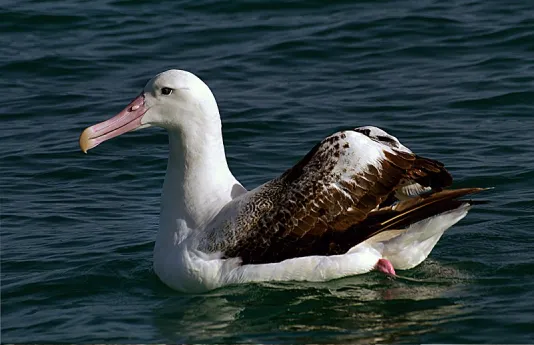
- Scientific Name: Diomedea exulans
- Length: 42.1-53.1 in
- Wingspan: 98.8-137.8 in
- Weight: 13-28 lb
Also known as snowy and white-winged, wandering albatrosses are one of the largest birds in the world. Adults usually measure from 3 ft 6 inches to 4 ft 5 inches and weigh 13 to 28 pounds – males are slightly bigger than females.
They have the longest wingspan of any bird, reaching 12 ft 2 inches. Because of that, they can stay in the air for several hours without flapping their wings once. These birds spend most of their lives in the air and only land to breed and feed.
Wandering albatrosses are common in the Southern Hemisphere, including the western coast of Africa. Their plumage can vary with age, but adults mostly have white bodies with black and white wings and large pink bills. The IUCN lists them as vulnerable with an estimated population of 25,500 birds in 2007.
6. Marabou Stork

- Scientific Name: Leptoptilos crumenifer
- Length: 47-51 in
- Wingspan: 88.8-112.8 in
- Weight: 9.9–17.6 lb
Marabou storks are the largest storks in the world, measuring up to five feet tall with a nine-foot wingspan in adults. The largest specimens can also reach 20 pounds in weight.
To keep their massive bodies up and running, they need to eat over 1.6 pounds of food a day. Marabou storks mostly feed on carrion, fish, frogs, snakes, rats, birds, and termites – they will often follow and wait for vultures to finish eating carrion before grabbing a piece.
These massive birds are native to sub-Saharan Africa, often around dry savannas, grasslands, swamps, riverbanks, lake shores, and receding pools. Marabou storks are easy to recognize by their black backs, white underparts, massive dagger-like bills (10.4-13.8 inches long), pink heads and necks, and long throat sacs.
7. Great White Pelican

- Scientific Name: Pelecanus onocrotalus
- Length: 55-71 in
- Wingspan: 89-141.7 in
- Weight: 20-33 lb
Great white pelicans are enormous birds, the second largest pelicans in the world, after Dalmatian ones. They are also known as eastern white pelicans or rosy pelicans and can measure 5.9 feet in length and weigh up to 33 pounds!
Great white pelicans also have dull pale yellow gular pouches and huge pink and yellow beaks that can measure up to 18.5 inches long. They are predominantly white with black flight feathers and yellowish bases on their necks.
Great white pelicans breed in Africa, southeastern Europe, and Asia, around swamps and shallow lakes. Their breeding season starts around April and a female will lay 1-4 eggs that both parents raise. Highly social birds, great white pelicans will often form large flocks.
They are carnivores that mainly feed on fish and need to consume 2-3 pounds per day.
Although adults are protected from other birds of prey due to their size, their eggs, nestlings, and fledglings can be in danger. Occasionally, jackals, lions, or crocodiles might hunt these large African birds.
Want to see what their white opposites look like? Check our list with examples of small white-colored birds.
8. Secretarybird

- Scientific Name: Sagittarius serpentarius
- Length: 43.4-59 in
- Wingspan: 74.8-82.7 in
- Weight: 8.2-9.4 lb
Secretarybirds are large African raptors easily distinguished from other birds of prey by their eagle-like heads and long crane-like legs that give them a height of up to 4 ft 3 in! They are endemic to the African continent, common in the open grasslands and savannas of the sub-Saharan region.
Secretarybirds were named in the 19th century due to their resemblance to male secretaries that wore gray tailcoats, dark knee-length pants, and goose-quill pens behind their ears. Their scientific name “sagittarius serpentarius” translates to “the archer of snakes” and refers to their incredible snake-hunting abilities.
Although they have large wings and can fly, they spend most of their days on the ground. Some scientists estimate that these tallest raptors in the world walk from 12 to 18 miles per day. Similar to some other eagle species, secretarybirds have heavy scales on their legs to protect them while walking through the brush or when attacking their prey.
They are diurnal hunters and eat anything they can catch, including mice, hares, insects, crabs, lizards, and snakes.
9. Martial Eagle

- Scientific Name: Polemaetus bellicosus
- Length: 31-38 in
- Wingspan: 74-94.5 in
- Weight: 4.9-14.3 lb
Martial eagles are the largest eagle species in Africa. Although they measure from 31 to 38 inches in length due to relatively short tails, these massive eagles can reach 7 ft 10 inches across their wings. Females are around 10% larger and over 30% heavier than males, reaching over 14 pounds.
Martial eagles can be identified by their short but prominent crests, brown heads, backs, chests, and pale bellies. Commonly found in woodland, plains, and semi-deserts of sub-Saharan Africa, they inhabit over 40 countries there, including Angola, Ethiopia, Senegal, Uganda, and Zimbabwe.
They hunt on the wing and surprise their prey from above, feeding on mammals, birds, and reptiles. Due to their underside spotting and ferocious efficiency in hunting, people sometimes call these apex predators “the leopards of the air”.
10. Lappet-faced Vulture
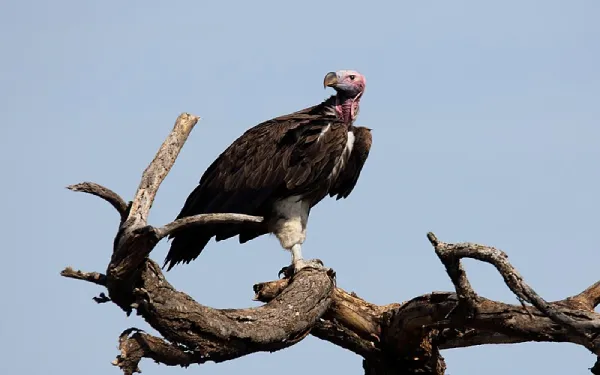
- Scientific Name: Torgos tracheliotos
- Length: 37-45 in
- Wingspan: 98.5-114.2 in
- Weight: 9.7-20 lb
Lappet-faced vultures are the longest and largest vultures in Africa that dominate other vultures during feeding. They measure up to 9.5 feet across the wings and reach an impressive 20 pounds in weight.
The species can be found in open areas with short grass and scattered trees, throughout most of Africa and on the Arabian Peninsula. They breed in Botswana, Ethiopia, Mali, Senega, Somalia, Tanzania, and many other countries.
When talking about appearance, lappet-faced vultures are blackish above with strongly contrasting white thigh feathers, yellow beaks, and wrinkled loose skin (lappets) on their faces.
They are scavengers that feed mostly on carcasses found by sight or by spotting other vultures. One of the most aggressive of large African birds, they use their strong beaks to tear off skin, tendons, and ligaments. The population of lappet-faced vultures has been on the decline and IUCN now lists them as endangered.
11. Kori Bustard
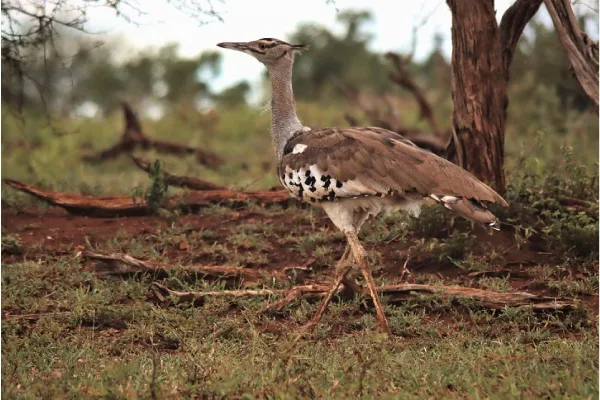
- Scientific Name: Ardeotis kori
- Length: 41.3-53.5
- Wingspan: 90.5-108.3 in
- Weight: 15-42 lb
Kori bustards are one of the largest flying birds native to Africa. There are 2 subspecies, a.k. kori found in Botswana, Zimbabwe, Namibia, southern Angola, South Africa, and Mozambique, and a.k. struthiunculus found in Ethiopia, Uganda, South Sudan, Kenya, and Tanzania.
Males are bigger than females with some males reaching 44 pounds of weight – this makes them one of the heaviest living animals capable of flight! These massive long-legged birds are very conspicuous with their brown and gray upperparts that are finely barred with black. The underparts are pale white or solid black.
12. Common Ostrich
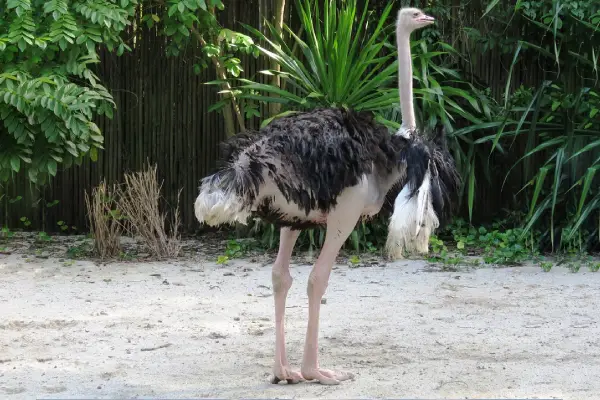
- Scientific Name: Struthio camelus
- Height: 82.7-110.2 in
- Wingspan: 79 in
- Weight: 139–320 lb
The common ostrich is the biggest African bird. With a height of over 9 ft and a weight of over 300 pounds, it is also both the tallest and heaviest.
It has a distinctive appearance, a long neck, and robust legs that help it reach up to 40 mph in a short burst. This also makes the common ostrich the fastest land bird.
Mature males have black-and-white plumage and pinkish skin while the females are duller grayish-brown. Common ostriches are found across Africa’s hot savannahs and open woodlands.
These flightless black birds also have huge eyes that are larger than their brains. Ostriches also have long eyelashes that help protect their eyes from sandstorms, just like in camels, and can survive almost two weeks without water.
And contrary to popular belief, ostriches don’t bury their heads in the sand to avoid predators. They lay their eggs in the ground and need to rotate them a couple of times per day, giving the wrong head-in-sand appearance.
Read More: What are some examples of African animals with stripes?
Summary
Africa is home to a remarkable array of bird species, boasting a rich tapestry of colors, melodies, and sizes. Examples of big African birds include the common ostrich, wattled crane, great white pelican, secretarybird, and many others.
From the sun-drenched savannahs to the dense rainforests, Africa offers an abundance of habitats that have nurtured the evolution of these avian giants over countless generations.